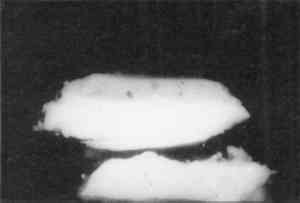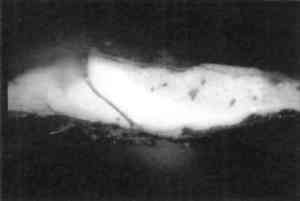CORCORAN AND CODY: THE TWO VERSIONS OF THE LAST OF THE BUFFALODARE MYERS HARTWELL, & HELEN MAR PARKIN
2 ANALYSISBoth paintings are executed in an oil-based paint on medium-weight, tabby weave linen canvas and are remarkably similar in appearance. However, the Corcoran painting is 11 1/8 in. taller (28.2 cm) and 22 1/4 in. wider (56.5 cm) than the Cody version. The Corcoran painting had been lined twice prior to 1984 and was not mounted on its original stretcher. Nevertheless, its tacking margins indicate that within approximately onequarter inch these are the original dimensions. The dimensions of the Cody painting/represent those of the stretcher added during a restoration undertaken about 1955, just prior to its sale. The dealer had the painting lined and mounted on a new stretcher because he considered the original panel-back stretcher, a type often used by Bierstadt, too heavy (Nicholson 1956). The tacking margins have been irregularly cut off and part of the farthest antelope to the left is missing, suggesting that more has been cut off along the left than along the other sides. Nevertheless, a comparison of the two compositions indicates that the Cody version is substantially complete, and the difference in size cannot be accounted for by the painting's having been cut down. Instead, because of its smaller size the Cody painting is slightly reduced in scale in relation to the Corcoran painting. Compositional elements are smaller, and the internal space is compressed. For example, the large standing buffalo at left is about 10% smaller in the Cody version. The compression of space is most apparent in details, such as the distance between the animals in the right foreground; in the Cody painting the buffalo are much closer together, and less of the dead horse is visible between them. Other differences, less important to the sense of space, also occur; in the Cody painting, the buffalo at the right center edge are running, while in the Corcoran version they have fallen to the ground. While the Corcoran painting has a slightly warmer (more yellow) palette, particularly in the sky, both paintings follow the technique establshed by Bierstadt early in his career. Cross sections reveal a thick lead-white preparation over which thin, relatively opaque layers of oil paint have been applied to build up the design (Berrie and Palmer 1986, 1988a, 1988b). In the Cody painting, however, between the canvas and the
Analysis of the paint in the sky reveals that in both paintings the blue is composed of a mixture of natural ultramarine and cobalt blue (with a slight predominance of the former) with lead-white. Analysis of the dark green at the left tacking The texture of the canvas is clearly visible through the paint and ground in both paintings. In addition, both paintings have a curiously granular surface appearance, in contrast to the smoother surfaces that Bierstadt's paintings usually exhibit. It is possible that Bierstadt may actually have textured the ground layer. In the Corcoran picture the paint suffers from a lack of binding medium, which increases the granular effect. In the course of treatment, the paint was found to be quite fragile and poorly attached to the ground, with pinpoint losses throughout. In the Cody painting the granular appearance is intensified by an overall pattern of tiny wrinkling in the paint, which could have been caused by inadequate adhesion between the slick, greasy graphite layer and the lead-white ground or between the ground and paint, a condition perhaps exacerbated by the glue lining. Abrasion from previous cleanings has made the surface texture more apparent in both paintings, particularly the Cody, in which extensive damage has occurred in the dark paint layers of the foreground. In the darks of the Corcoran painting there is also a small network of shrinkage cracks through which the white ground is visible. These cracks do not appear in the Cody picture. They may be the result of |

